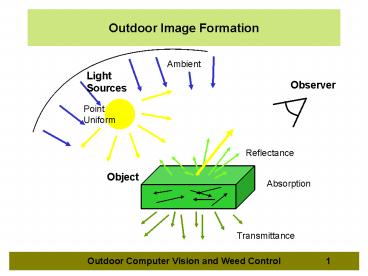Outdoor Image Formation - PowerPoint PPT Presentation
1 / 31
Title:
Outdoor Image Formation
Description:
'Full' Dichromatic Reflection Model. Objects as silk, wool, coloured paper. Type III. Special Version of the Dichromatic Reflection Model. Adaptable for Metals ... – PowerPoint PPT presentation
Number of Views:46
Avg rating:3.0/5.0
Title: Outdoor Image Formation
1
Outdoor Image Formation
Ambient
Light Sources
Observer
Point Uniform
Reflectance
Object
Absorption
Transmittance
2
Image Formation and Representation
Spectral integration
Illumination
Reflectance
Observer
Chromaticity
3
Dichromatic Reflection Model
Type I Neutral Interface Reflection, Objects
with high oil, water content Type II Full
Dichromatic Reflection Model Objects as silk,
wool, coloured paper Type III Special Version
of the Dichromatic Reflection Model Adaptable
for Metals
Reflected Light
Body Reflection
Surface Reflection
Tominaga, 1994
Shafer S.A. 1985
4
Dichromatic Reflection Model
5
Dichromatic Reflection Model
Chromaticity Representation
6
Spectral Variation of the Illumination
If Spectra of Light Source Changes
Spectra of Reflected Light Changes
7
Modelling Daylight
Correlated Colour Temperature, CCT
Judd et al., 1964 CIE standard
Typical Daylight 5700K
Range 4000 25000K
8
Modelling Daylight Changes
9
Physics Based Analysis of Outdoor Images of
Vegetation
- Assessment of Illumination Condition
- Segmentation of Images
- Dedicated Sensor
10
Assessment of Illumination Conditions
M2
M1
b(E1)
b(E2)
s(E1)
s(E2)
11
Assessment of Illumination Conditions
Sun and Skylight
Skylight
12
Assessment of Illumination Conditions
13
Assessment of Illumination Conditions
Object Vegetation
The Daylight Heuristic
Illumination Daylight, CIE
Observer 3CCD, Sony
Surface Reflectance N.I.R
Body Reflectance Shull 1929, Billings and
Morris 1951, Wooley 1971, Maas and Dunlap 1989
14
Assessment of Illumination Conditions
Experiments
Results
Pre Classification of Images
A. Sunshine, unclouded. Triangle
B. Sunshine, clouded. Point
Class B, C, and D
Class A
C. Skylight, clouded. Point
D. Skylight. Point
15
Assessment of Illumination Conditions
Conclusion
The current illumination conditions of
vegetation may be assessed by locating and
describing its pixel points chromaticities.
16
Segmentation
- Invariant to CCT changes of Daylight
- Secondary Reflections
17
Segmentation
Overlapping Clusters
Chromaticity r
Wilks lambda
18
Segmentation
Experimental Data
a
b
c
d
19
Results
20
Segmentation
Conclusion
- In the rgI space we may find a direction
- invariant to CCT changes of the illumination
- Wilks lambda shows the desirable property
- of dividing the uncertain class into vegetation
and soil
21
Dedicated Sensor
- Choose wavebands according to
- reflectance characteristics of vegetation
- Balance sensor according to vegetation
- Model Sensor behaviour into the near infra red
region
22
Dedicated Sensor
Design
Reflectance of Vegetation and Soil
Extension of Daylight Modelling
Characteristic of Sensor
23
Dedicated Sensor
Evaluating Sensor Behaviour
24
Cluster Shape and Location
25
Dedicated Sensor
Polar Representation of Chromaticities
26
Dedicated Sensor
Comparison of Waveband Combinations
alpha
red/near infra red
red/green
near infra red
27
Summary
Computer Vision in Relation to Weed Control
Dedicated Sensor
Early growth stage
Assessment of Illumination
28
Dichromatic Reflection Model
29
Dichromatic Reflection Model
30
Assessment of Illumination Conditions
Pre Classification of Images
B. Sunshine, clouded. Point
A. Sunshine, unclouded. Triangle
C. Skylight, clouded. Point
D. Skylight. Point
31
Segmentation
Results for Image b































